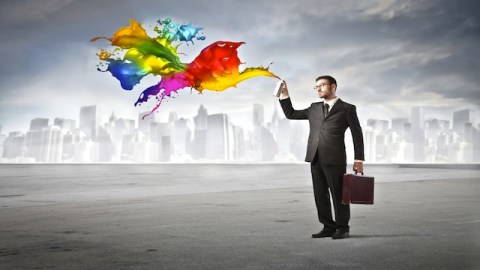Is Creativity Sexy? The Evolutionary Advantages of Artistic Thinking

Human evolution is puzzling. Around 45,000 years ago, for no obvious reason, our species took off. Our technology rapidly progressed, populations thrived and we started painting and crafting instruments. All of this and more culminated in our first civilizations. From there, we started growing food, building cities, reading and writing. Today, our species is the most dominant on the planet.
What’s odd is that natural selection doesn’t explain this cultural explosion. Our genetic makeup is identical to our ancestors who lived 100,000 years ago. As Matt Ridley explains, “all the ingredients of human success—tool making, big brains, culture, fire, even language—seem to have been in place half a million years before and nothing happened.” What gives?
The answer might have to do with the relationship between creativity and sex. Consider a study (pdf) conducted by evolutionary psychologist Douglas Kenrick, Bob Cialdini and Vlad Griskevicious. In one clever experiment the psychologists asked college students to write a short story about an ambiguous picture. Before the students tested their prose, Kenrick and his partners divided them into two groups. One half was put in a mating mindset by looking at six photos of attractive females, picking which one they most desired as a romantic partner and imaging an ideal date with her. The other half, the control condition, saw photos of a street and wrote about the most pleasant weather conditions for walking around and looking at the buildings.
Kenrick and his team found that students in the mating mindset were more creative with their stories of the ambiguous pictures than the control group. Did the reproductive motivations trigger their creativity? Because the effect only showed itself for the men, the researchers concluded that, “these studies establish that temporary activation of a mating motive can have the same effect on humans as the mating season has on peafowl; in both cases, mating opportunities inspire males to strut their stuff.”
Kenrick was also interested in the relationship between creativity, non-conformity and sexual selection. He wondered if sexual motivations cause males to stand out from the crowd artistically. To find out Kenrick teamed with Chad Mortensen and Noah Goldstein and asked subjects to judge how interesting they found an artistic image. However, before the subjects gave their two cents they listened to the judgments of several other members of the group who tended to agree with each other. Did the subjects conform to the group?
It depended on gender and motivational state. Kenrick and his team created two groups. One was primed with a fearful mindset by recalling tragic murder stories. Subjects in the other group imagined themselves spending a romantic day with the person of their dreams. The different motivational states mattered. Those in the mating mindset tended to go against the group opinion compared to their more fearful peers. Women did not show the same effect suggesting that when it comes to artistic taste, men are motivated to show off by strutting their creativity. (pdf of study)
This helps explains why muses are predominantly women who inspired men. Consider, as Kenrick did, examples throughout history:
Pablo Picasso [is] the most prolific artist in history with an astounding 147,800 works of art… a closer look at Picasso’s generative periods reveals an intriguing constant: Each new epoch blossoms with paintings of a new woman—not a sitter or a model, but a mistress—each of whom is touted to have served Picasso as an incandescent, albeit temporary, muse. Picasso’s artistic history, however, is not unique: Creative juggernauts such as Salvador Dalí, Friedrich Nietzsche, and Dante were also acutely inspired by their own muses. The enigmatic notion of a muse is rooted in Greek mythology, in which nine godly muses traversed the land, stirring the creative spirits of mortal artists and scientists. And according to historian Francine Prose (2002), all muses share one striking and inextricable feature: Muses—both in history and in mythology—are universally female. Yet if “there is no biological reason why a man can’t provide the elements of inspiration” (p. 9, Prose, 2002), how could it be that the elixir of inspiration seems to be primarily concocted by women and predominantly imbibed by men?
It appears that the answer has to do with sexual selection. Does this explain how our species went from hunting and gathering to mass-producing iPhones and airplanes? There are many pieces to that puzzle. The relationship between sex and creativity might be one of them.
olly/shuttershock




